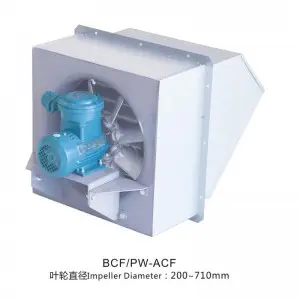1. Since there is a large difference between the air temperature and the grain temperature, the first ventilation time should be chosen during the day to reduce the gap between the grain temperature and the air temperature and reduce the occurrence of condensation. Future ventilation should be carried out at night as much as possible, because this ventilation is mainly for cooling. The atmospheric humidity is relatively high and the temperature is low at night. This not only reduces water loss, but also makes full use of the low temperature at night and improves the cooling effect. .
2. In the initial stage of ventilation with a centrifugal fan, condensation may appear on doors, windows, walls, and even slight condensation on the surface of the grain. Just stop the fan, open the window, turn on the axial fan, and turn the grain if necessary to remove the hot and humid air from the warehouse. Just outside the warehouse. However, when using an axial flow fan for slow ventilation, there will be no condensation. Only the grain temperature in the middle and upper layers will rise slowly. As the ventilation continues, the grain temperature will drop steadily.
3. When using an axial flow fan for slow ventilation, due to the small air volume of the axial flow fan and the fact that grain is a poor conductor of heat, slow ventilation is likely to occur in individual parts in the early stages of ventilation. As ventilation continues, the grain temperature in the entire warehouse will gradually become balanced. .
4. The grain that undergoes slow ventilation must be cleaned by the vibrating screen, and the grain that enters the warehouse must be promptly cleaned of the impurity area caused by automatic classification, otherwise it may easily cause uneven local ventilation.
5. Energy consumption calculation: No. 14 warehouse has been ventilated with an axial flow fan for 50 days in total, an average of 15 hours a day, a total of 750 hours. The average moisture content has dropped by 0.4%, and the grain temperature has dropped by an average of 23.1 degrees. The unit energy consumption is: 0.027kw .h/t.℃. Warehouse No. 28 was ventilated for 6 days in total, for a total of 126 hours. The moisture content dropped by 1.0% on average, the temperature dropped by 20.3 degrees on average, and the unit energy consumption was: 0.038kw.h/t.℃.
6. The advantages of using axial flow fans for slow ventilation: good cooling effect; low unit energy consumption, which is particularly important today when energy conservation is advocated; ventilation timing is easy to control and condensation is not easy to occur; no separate fan is required, which is convenient and flexible. Disadvantages: Due to the small air volume and long ventilation time; the precipitation effect is not obvious, it is not suitable to use axial flow fans for ventilation of high-moisture grains.
7. Advantages of centrifugal fans: obvious cooling and precipitation effects, short ventilation time; disadvantages: high unit energy consumption; condensation may easily occur if the ventilation timing is not mastered well.
Conclusion: In ventilation for the purpose of cooling, axial flow fans should be used for safe, efficient, energy-saving slow ventilation; in ventilation for the purpose of precipitation, centrifugal fans should be used.
Post time: Jan-16-2024

